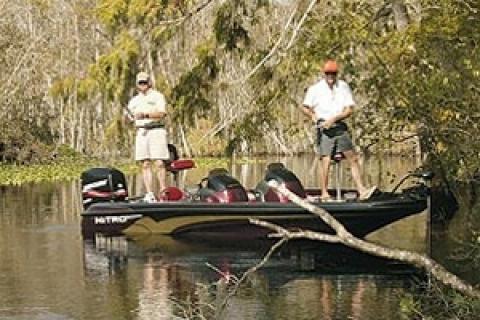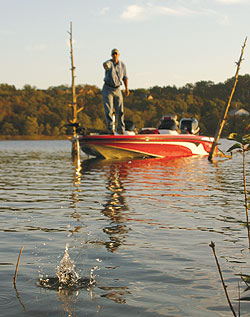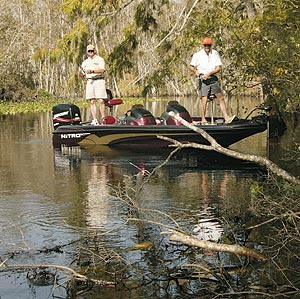
A trait of any successful angler is being able to put a pattern together that'll catch fish. One key component to a pattern is lure retrieve. Jigging, hopping, twitching, and jerking are some terms to describe how to add life to a bait with your fishing rod and reel. In this article I'll look at four tried-and-true retrieve styles but before over-viewing them, a few words first on gear...
 |
| Using different types of rods, reels and line will impact the effectiveness or believability of your lure's presentation. |
Imparting Action
Essentially lures are manipulated by the fishing line to which they are tied. These line movements are controlled by the angler through rod and reel movements. In some respects anglers act as puppeteers to their lures, giving life to inanimate objects. Using different types of rods, reels and line will impact the effectiveness or believability of your lure's presentation.
For example, no matter how much you discipline yourself to slowly work a muskie jerkbait in the fall, if you're using a high-gear ratio reel, you won't achieve as slow of a retrieve if you were to use a low-gear ratio reel. Line diameter serves as another example. The larger the line's diameter, the more water resistance it creates. If using diving lures, like crankbaits, the bait will dive deeper on a smaller diameter line, which is why many anglers have switched to superbraid lines to maximize a bait's running depth. Superbraids maintain a respectable pound-test, but have a smaller diameter if compared to a same-pound test monofilament line.
1. A Straight Lure Retrieve
Beginning with the most basic of fishing styles is a straight retrieve. The lure is brought through the water through the intake of line via the reel. The rod is used very little, although it may be raised or lowered slightly to make the bait ascend or descend in the water column or to add some variety to the lure's action. Any rod type can be used for a straight retrieve as long as it has enough power to handle the bait's resistance when reeled in. Opt for reels with high-gear ratios if you want to bring baits in quickly and choose low-gear ratio reels if you want a slow retrieve speed.
A straight retrieve is effective for many reasons. The fact that the bait maintains a undeviating trajectory and speed (in most cases) makes it easy for fish to find and hit the lure. This style of retrieve is also an excellent way to cover a lot of water to find active fish, such as using spinnerbaits or crankbaits for bass or muskie.
This type of retrieve also works well when fishing jigs or swimbaits for suspended fish. Count the lure down to a specific depth and then retrieve it through this section of the water column. Another benefit of the retrieve is that you have constant feel of the lure because it's on a tight line, which means you shouldn't miss feeling any hits.
2. Jigging Lures
I've heard several pro anglers and outdoor personalities state, "If I had to choose only one lure to use, it'd be a jig." In most cases, they were referring to a simple jighead teamed with a tube or twister-tail, soft-plastic body. For most jigs, spinning rods and reels are used. Longer rods, like seven to eight footers, offer more control and take up more line on the hookset. Choose a rod with a sensitive tip to detect hits but one that also has adequate backbone to set the hook and handle big fish.
The basic jigging retrieve begins by casting the bait out and letting it fall to the bottom on controlled line. This will let you detect any hits as it sinks. Once the bait stops, it's worked along the bottom. This is done by raising the rod (from a 10 o'clock to 11 o'clock position), which lifts the jig off the bottom and brings it forward. Next, the rod is lowered to its original position (10 o'clock), the jig falls back to the bottom, and line is retrieved with the reel until taut. At this point, some anglers may pause before beginning the retrieve again.
Variations to jigging include reeling while the rod is lifted to make baits swim longer distances. Another is not using the rod to move the bait but rather employing a few quick turns of the reel to cause the bait to shoot upwards and forwards, before falling again when you stop reeling. When drift fishing or vertical jigging, anglers simply need to maintain contact with the bottom and raise and lower the rod to jig the bait. Short, smaller movements that subtly move the bait are sometimes referred to as hopping, which is a variation on a jigging retrieve.
 |
| Don't be afraid to experiment with various ways of bringing in baits. |
3. Twitching Lure Retrieve
Twitching is an erratic retrieve. The majority of the lure's movement is the result of short, fast rod movements. This causes the bait to quickly move a short distance. The frequency and number of twitches can be varied to create dozens of patterns; however, retrieves consisting of a few twitches and then a pause seem to be the most popular.
Work baits quickly for aggressive fish and slowly for neutral or negative mood fish. The pause is important when twitching to increase your hooking percentages. The twitching often attracts fish, but the erratic retrieve can be tough for fish to successfully strike. Adding a pause to a retrieve gives fish a chance to zero-in on the lure and hit it.
Twitching is favored with hard- and soft-plastic jerkbaits, glidebaits and topwater baits. Although some prefer spinning rods to work hard-plastic jerkbaits or minnowbaits, baitcast combos tend to be preferred for twitching. Regardless, choose a medium to a heavy rod to handle your quarry of choice. The rod should have little give in the tip, so that when you twitch the bait, little energy is absorbed by the rod, but transferred directly to the bait itself.
4. Jerking or Sweeping Lure Retrieve
Jerking could be considered a close cousin to twitching. This retrieve style is mainly dependant on rod manipulation to impart the right action to the bait. Jerking consists of longer, sweeping rod movements and the rod that is pulled downward or to the angler's side. Next, the rod is returned to the starting position and slack line is recovered with the reel. Once the line is taut, the angler performs another rod sweep. This style of retrieve is mainly used for the aptly-named jerkbaits. The sweeping of the rod causes these baits to dive slightly, or swim to the side. On the pause baits will either sink, suspend, or float, depending on their material and design.
Baitcast rods are the norm for jerkbait fishing and they should be a medium- to a heavy-action with little give in the tip. If you use a flexible rod when jerkbait fishing, baits will not perform properly. Also, you'll likely tire yourself out from using a lot of energy to move baits because the rod tip is bending, and reducing the distance a bait will move.
If you plan on jerking your baitcast rod downward (from a 9 o'clock to 6 o'clock position) consider purchasing a shorter rod to ensure you don't hit the water's surface with the rod tip. Plunging the rod tip in and out of the water requires more energy and can cause freeze-up on cold autumn outings. For example, a muskie jerkbait rod for a man of average height should fall somewhere between six to six and a half feet in length, with models at six feet, three inches being quite popular.
The above are the four basic retrieve styles upon which many variations can be created for specific lure presentations. For example, helicoptering a spinnerbait is simply a hybrid of a straight and jigging retrieve. Don't be afraid to experiment with various ways of bringing in baits. Just make sure you remember the retrieve pattern that got a fish to hit, so you can repeat it can catch a lot more!
- 60805 views

